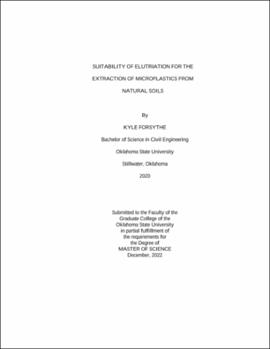| dc.contributor.advisor | Gonzalez-Estrella, Jorge | |
| dc.contributor.author | Forsythe, Kyle | |
| dc.date.accessioned | 2023-08-02T19:47:05Z | |
| dc.date.available | 2023-08-02T19:47:05Z | |
| dc.date.issued | 2022-12 | |
| dc.identifier.uri | https://hdl.handle.net/11244/338776 | |
| dc.description.abstract | Microplastics are a class of emerging contaminant which pose serious risks to the health and safety of terrestrial and marine ecosystems. Much research has been conducted regarding the prevalence of microplastics in marine environments; however, the vast majority of microplastics wash into the ocean via freshwater systems where research into the spatial and temporal distribution of microplastics is severely lacking. The lack of research into this field is largely due to the absence of any standardized methodology for the extraction of microplastics from a broad range of soils. Though many processes are available for the separation of plastics from certain constituents of soil, the complex and heterogeneous nature of both soils and plastics makes this process complicated and time-consuming, and not all soils require the same treatments. As such, no widely-accepted methodology is available for the extraction of microplastics from soils, which makes comparisons between studies difficult. This study aims to evaluate if elutriation, a method commonly employed in marine microplastic extraction, is effective for the separation of plastics in a broad range of soils. Five soils of varying composition were collected from freshwater and terrestrial ecosystems in Oklahoma, and were subjected to microplastic extraction with and without elutriation, followed by identical digestion and flotation steps. The number of extracted particles was compared, and linear regression was performed to identify trends between relative particle extraction and soil composition. Multiple strong correlations were observed, indicating that elutriation can be used to increase particle extraction in sandy and silty soils, while clayey and organic-rich soils showed greater particle extraction without elutriation. This suggests that soil composition is indicative of which extraction methodology results in greater yield. The information gathered here will provide other groups with a rapid and inexpensive method for determining the optimal procedure for microplastic extraction from soils, paving the way for a standardized extraction methodology. | |
| dc.format | application/pdf | |
| dc.language | en_US | |
| dc.rights | Copyright is held by the author who has granted the Oklahoma State University Library the non-exclusive right to share this material in its institutional repository. Contact Digital Library Services at lib-dls@okstate.edu or 405-744-9161 for the permission policy on the use, reproduction or distribution of this material. | |
| dc.title | Suitability of elutriation for the extraction of microplastics from natural soils | |
| dc.contributor.committeeMember | Jilling, Andrea | |
| dc.contributor.committeeMember | Krzmarzick, Mark | |
| osu.filename | Forsythe_okstate_0664M_17973.pdf | |
| osu.accesstype | Open Access | |
| dc.type.genre | Thesis | |
| dc.type.material | Text | |
| dc.subject.keywords | contaminant | |
| dc.subject.keywords | elutriation | |
| dc.subject.keywords | extraction | |
| dc.subject.keywords | microplastic | |
| dc.subject.keywords | polymer | |
| dc.subject.keywords | soil | |
| thesis.degree.discipline | Civil Engineering | |
| thesis.degree.grantor | Oklahoma State University | |
